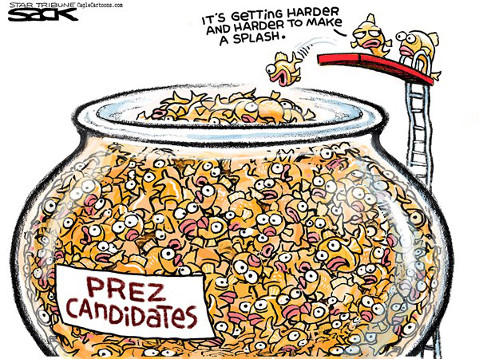Don’t Run with Scissors
Remember Deficit and Debt Swings During Strained Economic Times

The Republican Party has made what it calls the tax-and-spend policies of the Democratic Party a call to arms for more than 30 years. The battle cry for conservatives and their Tea Party compatriots is that the Democratic liberal wing has failed to solve problems from economic stagnation to lifting people out of poverty. In their thinking, imposing big government with its bureaucracy and corresponding big spending has been a monumental failure. Whoever survives the Republican primaries and becomes the standard bearer to run for president will paint a grim economic picture of this country should a “free spending” Democrat win the presidency. Save one, the Republicans have yet to win the White House on a platform of cutting taxes and cutting spending. And these self-contradictory planks have kept the Republican-led Congress from governing since 2010.
Ronald Reagan, who bucked the trend by running on an economically conservative agenda and won, found talking the talk was far easier than walking the walk of fiscal austerity. (President Reagan raised taxes 11 times and saw the national debt rise from $700 billion dollars to three trillion.)
In our political paradigm the words “budget deficit” and “national debt” have oftentimes taken center stage. On one level this is quite understandable as many of us are taught early to live within our means and when the government doesn’t it appears to be irresponsible.
The misunderstanding is that comparing household budgets to a government budget of the richest country in the world is truly a comparison of apples and oranges. Even more confusing for some is the difference between the yearly budget deficit run by the government and the overall national debt. This is a good place to begin a thoughtful conversation.
A yearly budget deficit (or budget surplus in good years) is the combination of income the government receives minus all the expenses the government must pay to keep the country running. The national debt is the accumulation of debt this country has incurred since its inception. Deficit and debt are only one side of the equation. The other is the percentage of budget deficits and national debt compared to GDP. For most economists across the political spectrum, it is this ratio that measures the financial health of the U.S., or any country for that matter. How healthy is our economy today compared to 20th-century America? And when the budget deficit or national debt rises, on which party do we place the blame?
At the time George Washington was elected to the office of President, the United States was over $75 million in the hole. A majority of the debt was due to the cost of the Revolutionary War. Congress in 1917 for the first time in our history created a statutory limit for the national debt when it allowed the Treasury to issue long-term bonds. This “ceiling” on the debt did not last long.
After the Great Depression and WWII, the necessity to spend to revitalize the economy increased our debt to 104 percent of GDP. This was seen as the only way to boost commerce after unemployment in the 1930s had reached 25 percent and with the astronomic costs of waging a two-front war against Nazi Germany and Japan. Downward spirals in the national economy and war once again proved to be the main sources for the rise in budget deficits and the national debt. This was a history lesson our leaders continued to take lightly from 1945 to the present.
From 1940 to the present the federal fiscal budget has seen a surplus only 11 times. Those are fairly evenly divided between Democratic and Republican administrations with the Democrats holding a slight edge. What is remarkable is that in this century, after President Bill Clinton left office, we had the largest budget surplus in our history, and since then, under eight years of the Bush administration and six of the Obama administration, our budget has constantly been in the red.
This is no surprise because under George W. Bush we increased military spending on two wars — Afghanistan and Iraq. President Bush pushed legislation for a $400 billion Medicare reform for prescription drug benefits. And two Bush tax cuts that reduced revenue by $1.8 trillion left the next president, Barack Obama, with much the same scenario that faced President Franklin Roosevelt 75 years before: a hemorrhaging economy that was losing jobs every month and wartime expenses that were not paid for by the previous administration. The actions by the Bush administration were a recipe for disaster and choices on the menu to fix the problem were limited. The Obama administration was forced to help enact and oversee the largest stimulus ($832 billion) since our inception as a nation.
This brings the discussion to the 2016 Republican campaign for president. When it comes to the economy, cutting taxes and cutting spending are high on their list of sound bites. This despite the fact that the ratio of national debt to GDP is similar to the post-WWII number and the budget deficit has significantly improved under the Obama administration from as high as 10 percent to today’s 2.75 percent of GDP.
After 1945 America witnessed the largest increase in the middle class. With legislation like the G.I. Bill, our country’s veterans returning from war were able to afford a college education and purchase a home. And our infrastructure of bridges and highways experienced a renaissance in rebuilding that not only allowed people to travel more but allowed goods to be transported in a far more efficient way.
Growing an economy, whether it be here, or as we have seen in rising industrialized nations like Germany or China, requires less congressional gridlock and more bipartisan efforts to pass an infrastructure spending and jobs programs. Trickle-down economics for the middle class and the poor is aptly named. A stream would be a welcome relief.
At the previous Republican presidential debate, perhaps the most interesting exchange occurred between Senator Marco Rubio and Senator Rand Paul. Rubio wants America to take the fight from the Middle East to the Far East and said, “The world is a safer, better place when America is the strongest military power.” Paul answered that this country’s military budget is as high as the next 10 nations combined. Then he added, “Marco, how is it conservative to add a trillion dollars to the expenditure of the federal government?” If senators Rubio and Paul want to really fire up the engine of the American economy, instead of their respective bases, and compete in a general election, they need only look back to our country’s past to see a brighter future depends on activist government participation for an equal and dynamic economic recovery.



